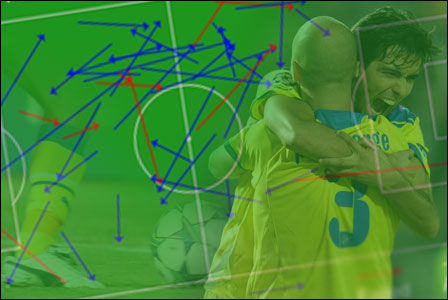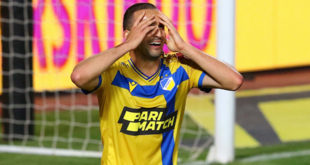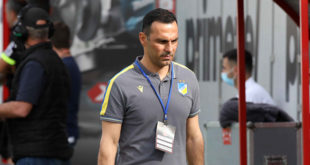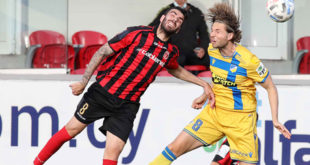Μια άκρως ενδιαφέρουσα ανάλυση του τελευταίου μας άθλου φιλοξενείται στην ιστοσελίδα zonalmarking.net, η οποία εξειδικεύεται σε θέματα τακτικής ποδοσφαίρου. Κάτω από τον τίτλο “The APOEL miracle continues” γίνεται μια λεπτομερής ανάλυση της στρατηγικής που ακολούθησε ο Γιοβάνοβιτς στον αγώνα με την Πόρτο αλλά και το πώς εφάρμοσαν οι παίκτες την τακτική του Γιοβάνοβιτς. Στο γενικό τους σχόλιο γίνεται ιδιαίτερη μνεία στην αποτελεσματικότητα της επιθετικής γραμμής αφού αν και έχει το χαμηλότερο ποσοστό κατοχής (43%) από τις άλλες ομάδες, εφαρμόζοντας σωστά τις αντεπιθέσεις. Δεν επιτίθονται πολύ αλλά επιτίθονται καλά, αναφέρουν χαρακτηριστικά. Ακολουθεί η σχετική ανάλυση:
The clear outsider in a very strong group coming into the tournament, APOEL now find themselves top of Group G after a 2-1 win over Porto.
There was an element of fortune to their victory over Porto last night. Having deservedly got themselves into a 1-0 lead, they were content to sit on that slender advantage going into the final minutes. A rash challenge and a Hulk penalty later, they look like they’d blown their chance. But APOEL showed character to get up the pitch and score a 90th minute to clinch the win.
Coach Ivan Jovanovic prefers a 4-2-3-1 shape, and in simple terms there is relatively little unusual about the side.

DefenceThe back four is as you would expect – the full-backs are converted wingers but not overly attack-minded. With APOEL tending to play quickly on the break, there was often no need for overlapping runs to stretch the play – the front four were left to create chances themselves.
MidfieldThe midfield duo were interesting – unlike, say, Uruguay, they didn’t remain particularly close together throughout the game, and pivoted across the pitch to a great extent. When the play went down one flank, the holder on that side would move out a long way towards the wing to assist the play. The other covered in the centre. This isn’t particularly unusual, but it was notable how the movement was always out to the flank, not forward towards the strikers.

WingersThe wide players were crucial to APOEL’s good attacking moves – but not in the traditional sense. They would start relatively deep, and pull the Porto full-backs towards them, high up the pitch out of position. This created space for their front two to move into down the flanks, and then the ball was played past the wingers, they’d turn and sprint to provide support.
AttackThe movement from Ailton upfront was extremely impressive. He spent the time working the channels (and with the full-backs high up the pitch, the flanks), almost never picking up the ball in the centre. He has a great burst of pace and a good first touch, making him perfect for nipping in ahead of centre-backs and spinning in behind. He tended to pick up the ball in deep positions on the right flank, and then when moving to the left he tried to get on the end of balls over the top.
The reason for that difference was probably because the attacking central midfielder, Ivan Trickovski, tended to move towards the left. Therefore Ailton didn’t need to come short for the ball and could make runs in behind. Trickovski, incidentally, is able to play on either flank or through the middle – having played two games from the right in the Champions League this season, here he started in the middle and then switched with Manduca at half-time.
Ailton can’t be depended on for link-up play – he received 32 passes, but then only attempted 16, of which 8 were completed. In other words, when he gets the ball he only passes 50% of the time, and only keeps a move going 25% of the time. He’s a bit El-Hadji Diouf at the World Cup in 2002. In winning (and scoring) the penalty, however, he did his job upfront well.

The movement of the front two across the pitch, with the wingers moving forward, meant triangles down the flanks formed naturally. Porto struggled to get men over to stop these moves – the central midfielders couldn’t get out in time, whilst the wide forwards stayed up the pitch. None of the Porto backline had a good game individually.
The away side did form a good offside trap, catching APOEL offside ten times. Early on the forwards seemed to be moving too early, but the ball could have arrived much quicker from the centre of midfield – often the passer took an extra touch and allowed the defence to step up. A little more speed in these attacks, and APOEL could have got in behind much more.

Overall strategyAPOEL’s position are the top of the group is down to their attacking efficiency. They average the least possession (43%) in a very counter-attacking group, and average just eight shots a game, compared to Porto’s 22, Zenit’s 20 and Shakhtar’s 14. They don’t attack much, but they attack well.
They were guilty of being too conservative in the second half against Porto, though. They were clearly threatening Porto with pace in behind the defence, and the switch to a more conservative style meant the away side could throw men forward without fear of being exposed on the break. The decision to remove Ailton – who may have been tired – for centre-back Sanel Jahic on 77 minutes was a particularly negative move, and one sensed that APOEL would regret that change. They did – for a brief moment – before the late goal.
As far as weaknesses go, the way to get at APOEL would probably be to try and flood the centre of the pitch, forming a 3 v 2 against the two holding midfielders – Trickovski doesn’t look as if he wants to do much defensive work. That said, Zenit would be the perfect side to create triangles around those two players with their fluid midfield trio, and they too lost 2-1 in Nicosia. The return fixture between the sides, in St Petersburg, takes place in three weeks.
 apoel.net Η συνήθεια που έγινε εξάρτηση
apoel.net Η συνήθεια που έγινε εξάρτηση



